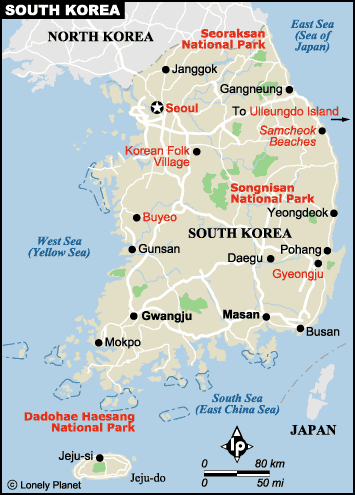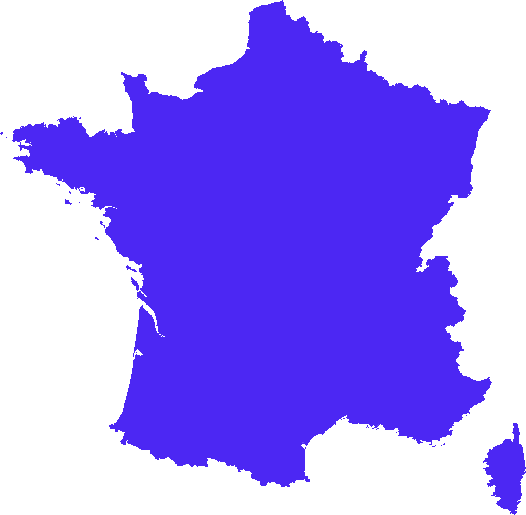|
|
|
Korea |
 |
|
South Korea is the resultant of the
Korea partition, the consequence of the nineteen fifties civil war. Many
authors consider that the existence of Korea is a
miracle considering the appetites of its neighbours for
several millennia.
The pugnacity of the Koreans to survive as a nation may result
from the Korean culture, syncretism of Buddhism, Confucianism and
Shamanism. This culture would also partly explain the economic miracle.
Korea appears ambivalent to Europeans visitors, because of opposition
between past and present.
The history of Korea is not the purpose of these pages. It is
outlined briefly to follow the vicissitudes of "the Land
of Morning Calm".
The geography of South Korea is presented in broad maps to
locate the journey. North Korea will not be studied.
|
|
|
|
|
|
History |
|
Geography |
|
|
|
|
According to Korean mythology, the year 2333 BC
may be the divine creation date of the Chosun
Kingdommeaning, the Land of Morning Calm. Moreover
until 1910, Korea counted the years from that date.
Actually, archaeological excavations attest the peninsula
settlement back to the paleolithic age.
From 108 BC to 313 AD, the Chinese empire occupied the
peninsula bringing its civilization, administration, art and
technology. Consequently Korea's development was inseparable from its powerful
neighbour.
From 57 BC to 668, rebellious tribes made up three
kingdoms, Koguryo in the north, Paekche in the south-west and
Shilla in the south-east. Buddhism was introduced into the peninsula
by the Kings of Paekche.
From 668 to 935, the unification proceeded from the Chinese threat
of the Tang dynasty by regrouping under the authority of Shilla.
Since 57 BC, the Shilla kingdom had its capital at Kyongju.
The appropriation of the lands by the State and their distribution
to civil servants caused the collapse of the kingdom.
From 935 to 1392, the Koryo kingdom, corruption of
Koguryo replaced Shilla and its capital was installed in Kaesong.
The Mongolian hordes devastated the country and dominated it until 1368
which put an end of the kingdom.
From 1392 to 1910, the Chosun kingdom took over the power and
established its capital at Hanyang, future Seoul.
From 1910 to 1945, Japanese colonization was terrible and left deep
scars in Korean mentality.
On August 15, 1945, the armistice with Japan was signed at the end
of World War II.
On August 15, 1948, the 1st Republic was founded.
From 1950 to 1953, the end of the civil war involved the
partition.
The End of the 20th century was marked by civil troubles and
four successive republics. |
|
Korea
is a peninsula within the borders of Asia from which it is separated by
two rivers, taking their sources at the Paekdu Mount, 2,744m
high, Yumen in the east and Yalu in the west. They constitute
the natural border with China and Russia.
Korea stretches 1,000Km from north to south and 500 km from east to
west at its widest and 200Km at its smallest.
The border of the armistice between the two Korea
is roughly along the 38th parallel.
South Korea is approximately
45% the surface of Korea that is to say 18% of France.
It is bordered in the east by the Sea of Japan, in the west by the
Yellow Sea and in the south by the East China Sea.
The mountains are 70% of the territory whose the highest summit is the Halla-san mount,
1,950m high, located on the Jejudo
island in the south-west. The range of mountains is directed North-South from the Paekdu mount
sloping down towards the south and
constituting the watershed between the east and the west.
The East part is abrupt with a
narrow coastal band and inlets sheltering fishing ports.
The Western part is gently sloping with rich coastal plains,
sand banks and tides among the highest of the
globe. There is no fishing port.
The Southern part, strewn with islands, is tropical and luxuriant.
South Korea has four
very marked seasons. Monsoon prevails in summer.
Autumn is the most pleasant season to visit South Korea. |
|
|
|
|
Located between the 38th and 33rd parallel, Korea has
temperate landscapes in the north - the vegetation is alpine beech, birches,
pine trees - and tropical landscapes in the south and more
particularly on the coast - where the vegetation becomes luxuriant, azalea,
camellia. Fauna is mainly made up of birds, pheasants, orioles. The
white crane is protected.
|
|
|
|
|
Economic facts |
|
Civilization |
|
|
|
|
Korea's economy is very developed. Korea was one of the five dragons of South-East Asia.
Agriculture provides 4,4% of the GDP.
Mineral resources
are not very important, they represent 0,3% of the GDP.
Industry is very developed in all the branches of industry, building, shipbuilding,
automotive engineering, machine tools, chemistry etc.
The sector provides 38,3% of the GDP.
Trade and services are also very important. They provide 54,1% of the
GDP. The services of the private sector amount to 43,7% of the GDP.
Trade, imports and exports, is among the most important of South-East Asia.
The Korean currency is Korean Won. |
|
The official name is Republic of Korea whose capital
is Seoul.
The population is +48 million inhabitants.
The official language of Korea is Korean which belongs to the
Ural-Altaic group of the settlement tribes during the paleolithic era.
The writing is Hangul conceived in the 15th century.
Koreans are Buddhist, Confucian, Shamanist and 25% Christian.
Confucianism is a philosophical ethics and an organizing ideology
of the social order by posing five rules of good attitudes between the
people:
1 between the sovereign and the subject,
2 between the father and the son,
3 between the elder and his junior,
4 between the husband and the wife,
5 between friends.
Shamanism dates from ancestral tribes of Central Asia. Buddhism
belongs to the school of the great vehicle, Mahayana. Christian was
established by the Jesuits and persecutions started in 1791.
The GNP is US$18.000 per capita. |
|
|
|
|
Due to its geographical and geological configuration, Korea provides
all the open air activities more especially as Koreans
are inclined to them naturally. Traditional arts, painting,
penmanship, ceramics and spectacles are as many sights to be seen
with traditional medicine and geomancy. |
|
|
|
|
Traveller's Information |
|
Sights |
|
|
|
|
Nationals of European countries and Canadians with a return ticket can stay in South Korea
up to 90 days visa-free. The other nationals of the countries recognized by South Korea can
stay 30 days.
On the health plan it is recommended to consult specialized websites, in
France the website of the Foreign Ministry. No particular precaution to
Korea, it is necessary to be up to date with the usual vaccinations.
The traveller's budget depends on his choices, South Korea offers little
opportunities for small budgets. |
|
The geographical situation of Korea, its climatic variety offer to
travellers multiple possibilities of activity.
There are twenty natural reserves. They offer all opportunities to sportsmen.
Sports activities are possible in all Korean areas, excursions, skiing, golf and
mountain biking.
In autumn 2003, I made a package tour in Korea in connection with
Japan. |
|
|
|
| Neuilly, le 2003/11/09 |
|

|
|
|
|
|